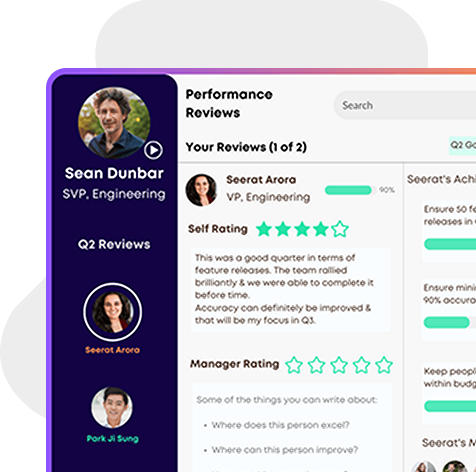

What are Employees Really Asking for in Reviews?
.svg)
Overview
If you listen closely, employees are telling you exactly what they need. This piece unpacks the quiet questions behind every performance review.
In my last piece, I wrote about a truth we all feel but rarely say out loud:
The annual review alone isn’t enough.
It doesn’t create impact.
It doesn’t build trust.
And it certainly doesn’t give leaders the visibility they need to develop and retain their people.
But once you understand that, another question naturally follows:
If the annual review isn’t enough… what are employees actually hoping to get out of performance conversations?
After years of leading teams through scale-ups, reorganizations, and everything in between… and now watching thousands of real conversations flow through Klaar, I can tell you this:
Employees aren’t asking for a score.
They’re asking to be understood.
Not the polished version.
Not the template version.
The real version.
And the questions they bring into these conversations, spoken or unspoken, reveal exactly where today’s performance systems fall short, and what leaders must evolve next.
Here’s what employees are really asking in reviews, even if the words never leave their mouth.
1. “Do you actually know what I do…or are you guessing?”
This is the most common fear I see.
Employees can tell immediately whether a review is based on:
- real work
- real outcomes
- real examples
…or a manager’s memory of the last two weeks.
When people sense that a review is built on proximity instead of evidence, trust evaporates long before the rating is shared.
2. “Is my extra effort invisible…or being taken for granted?”
Employees aren’t imagining it…workload creep is real.
We’re seeing it everywhere.
People are stepping into new responsibilities, often without acknowledgment or alignment.
So in reviews, the unspoken question becomes:
“You see all of this… right?”
If leaders don’t name it, employees assume the opposite… that the company is benefitting from their extra effort without recognizing it.
This is where disengagement starts.
3. “Am I building momentum… or am I stuck?”
One of the biggest signals of retention or attrition is whether an employee believes they have a future at your company.
In a review, they’re asking:
- Where am I growing?
- What’s next for me?
- Do you see potential, or just output?
If leaders don’t paint a clear picture of possibility, employees assume there isn’t one.
4. “Why am I hearing this now?”
This is the question that breaks trust faster than any rating.
Delayed feedback tells employees:
- the issue wasn’t important enough to address earlier
- or that leadership waited for the “formal moment”
- or that expectations were unclear all year
Nothing undermines credibility like holding feedback until the annual review.
If it isn’t timely, it stops being feedback and starts being an afterthought.
5. “Who decided this rating… and why?”
Employees are more informed than ever.
They know ratings are influenced by:
- budgets
- calibration sessions
- manager capability
- leadership visibility
So when leaders give a rating without transparent reasoning, employees question whether it reflects their work or the system’s constraints.
People don’t need perfect systems… they need honest ones.
6. “Do you see my potential… or just this moment?”
Employees want to know whether you see them through a wider lens:
- their leadership traits
- their influence across the team
- their capacity to take on more
- the strengths that aren’t on a scorecard
Potential is one of the strongest predictors of performance.
When leaders name it, people rise.
When leaders overlook it, people leave.
What These Questions Reveal
These aren’t questions about the review process.
They’re questions about:
- trust
- safety
- fairness
- alignment
- recognition
- future
- impact
And whether leaders realize it or not, the performance review has become the moment where all of that crystallizes.
It’s the checkpoint where employees ask:
“Do I see a future here… or do I need to create it somewhere else?”
So What Should Leaders Do?
If organizations want performance conversations that actually drive impact, they must evolve beyond the annual cycle.
Here’s what forward-thinking teams are doing:
- Create performance rhythms, not performance seasons. Weekly or biweekly 1:1’s or check-ins make reviews predictable, not emotional.
- Make expectations unmistakably clear. Employees can’t succeed at goals they don’t understand.
- Give feedback when it’s useful, not when it’s scheduled. Timely feedback builds trust; delayed feedback erodes it.
- Separate development from evaluation. Employees need a place to grow, not just a place to be judged.
- Document real impact throughout the year. This eliminates recency bias and builds fairness into the system.
Anchor reviews in forward motion. Close every conversation with: “What happens next?”... and make it actionable.
Wrapping Up
Employees don’t want performance reviews to go away.
They want them to matter.
They want conversations that feel:
- honest
- fair
- grounded in reality
- rooted in growth
- connected to the work they’re actually doing
- and reflective of the future they’re building
The organizations that embrace continuous performance, not annual performance, will be the ones that develop stronger talent, build deeper trust, and keep top performers longer.
Because when you treat performance as a partnership instead of an event, something powerful happens:
People don’t just perform. They perform wonders.
If you’re seeing similar patterns in your own performance conversations... the unasked questions, the concerns beneath the surface…I’d love to hear what’s working for you. Connect with me on LinkedIn so we can keep pushing this conversation, and our systems, forward.
With Clarity,
Lana Peters
Chief Revenue & Customer Experience Officer
.svg)
.svg)





.svg)

.svg)